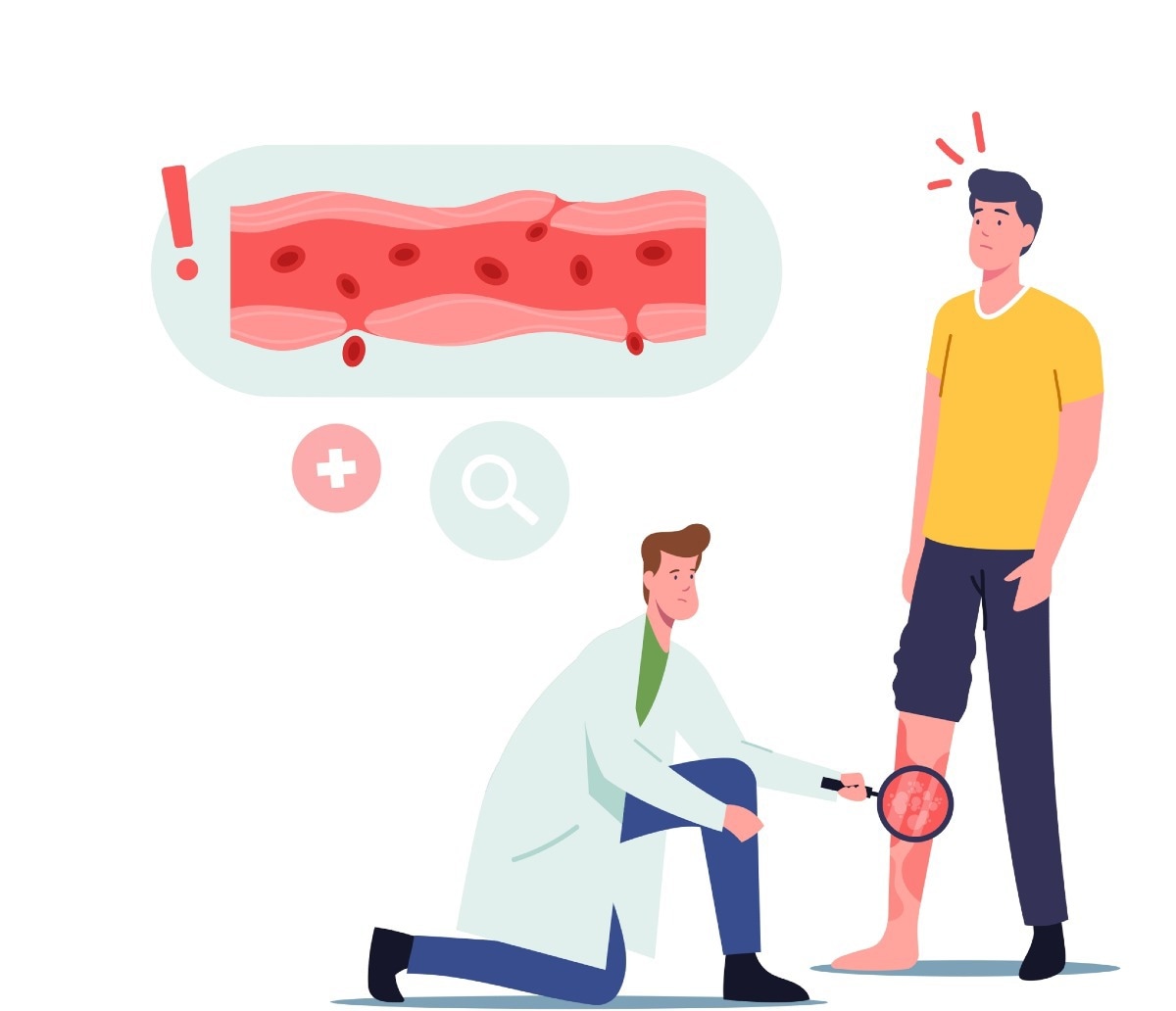COVID-19 may provoke IgA-associated vasculitis
In a recent case report posted to the Research Square* preprint server, scientists showed that severe acute respiratory syndrome coronavirus 2 (SARS-CoV-2) infection provokes immunoglobulin A (IgA)-associated vasculitis (IgAV).

Background
The most prevalent systemic vasculitis during developmental age is IgAV. It was previously known as Henoch-Schönlein Purpura (HSP) disease.
The high IgAV-linked morbidity rates during the winter and autumn months point to a connection between infectious factors, particularly an upper respiratory tract infection background. However, no specific trigger has been found thus far. The disease outbreak has reportedly been linked to adenovirus, streptococci, mycoplasma, parvovirus, influenza infection, and respiratory syncytial virus (RSV) in about half of the HSP patients.
SARS-CoV-2 was discovered initially in December 2019 in Wuhan, China, and it has since spread swiftly worldwide. Younger children, unlike adults, mostly experience a milder course of coronavirus disease 2019 (COVID-19), shorter time for symptom resolution, and reduced infectivity. Nevertheless, there have been very few reports of this virus causing significant consequences along with acute viral infection and linked phenomena like the multisystem inflammatory syndrome in children (MIS-C).
Notably, a few SARS-CoV-2 infection events linked to HSP have been described in recent publications in children and adults.
About the study
In the current work, the researchers presented the case of a seven-year-old girl with IgAV and COVID-19. She was admitted to the general pediatric department for additional testing after being diagnosed with HSP based on three clinical criteria (abdominal pain and palpable purpura, joint edema, and arthralgia) without renal engagement. In addition, the presence of IgG and IgM antibodies supported the diagnosis of SARS-CoV-2 infection in the girl.
The scientists evaluated the subject physically and conducted laboratory assessments during the hospital admission. Additionally, they performed SARS-CoV-2 antigen testing during hospitalization. Furthermore, an ultrasound of the abdominal cavity and a chest X-ray were conducted.
Results
The team noted that in the girl, a mild upper respiratory infection that was managed symptomatically came before skin abnormalities. Streptococcus pyrogenes infection probability was ruled out by negative findings from bacteriological tests and a low antistreptolysin O titer (ASO) titer. Moreover, Streptococcus pyrogenes, in addition to viruses, are thought to be one of the primary causes of HSP.
High inflammatory marker titers, like an elevated neutrophil count, a high neutrophil-to-lymphocyte count ratio (NLR), and leukocytosis were present at the admission time. Remarkably, the team has previously demonstrated with other authors that these markers were a reliable indicator of systemic involvement during HSP. The girl also experienced IgAV-related gastrointestinal bleeding, which has been linked to indicators, including increased NLR and the platelets to lymphocyte count ratio (PLR).
The patient was managed with parenteral hydration, prophylactic cefuroxime intravenous administration, and vascular sealing drugs such as cyclonamine and rutoside. Regardless of the treatment, the child's condition suddenly worsened on day 10 of hospitalization, along with significant gastrointestinal bleeding linked to anemia and elevated inflammatory markers linked with rotavirus diarrhea associated with nosocomial infection. Although rotaviruses can induce HSP, given the short incubation time of one to three days, this might not be the case in the current instance.
At first, 1 mg of prednisone was utilized to manage the child because of modest abdominal pain and stool containing occult blood. It was then substituted with methylprednisolone intravenously, administered following the recommendations.
The girl's IgG and IgM antibodies validated her SARS-CoV-2 infection. The researchers could not identify anti-SARS-CoV-2 IgA class antibodies in the girl. Notably, after receiving medication for three weeks, the serum IgA level initially rose and then fell. Additionally, two weeks after the onset of symptoms, levels of antigen-specific IgA substantially increased and continued to be raised for the following two weeks.
Conclusions
In the current case report of a seven-year-old girl with SARS-CoV-2 infection and IgAV, the team stated that a moderate upper respiratory infection treated symptomatically came before the presentation of the HSP. In addition, high titers of inflammation indicators were seen during hospitalization, including elevated neutrophil count, leukocytosis, and high NLR, markers linked to IgAV gastrointestinal hemorrhage. Further, these inflammatory markers were also present in the girl connected to rotavirus diarrhea.
Overall, the current case presented by the researchers and similar studies by other investigators suggests a probable function of SARS-CoV-2 in the emergence of HSP. However, further investigations are necessary to confirm this relationship.
*Important notice
Research Square publishes preliminary scientific reports that are not peer-reviewed and, therefore, should not be regarded as conclusive, guide clinical practice/health-related behavior, or treated as established information.
- Edyta Machura, Helena Krakowczyk, Katarzyna Bąk-Drabik, et al. (2022). Infection of SARS-CoV-2 as a trigger for IgA-associated vasculitis. Research Square. doi: https://doi.org/10.21203/rs.3.rs-1983848/v1 https://www.researchsquare.com/article/rs-1983848/v1
Posted in: Medical Science News | Medical Research News | Disease/Infection News
Tags: Abdominal Pain, Adenovirus, Anemia, Antibodies, Antigen, Arthralgia, Bleeding, Blood, Children, Coronavirus, Coronavirus Disease COVID-19, covid-19, Diarrhea, Drugs, Edema, Gastrointestinal Bleeding, Henoch-Schönlein Purpura, Hospital, Hydration, Immunoglobulin, Inflammation, Influenza, Laboratory, Lymphocyte, Mycoplasma, Pain, Parvovirus, Platelets, Prednisone, Research, Respiratory, Respiratory Syncytial Virus, Rotavirus, SARS, SARS-CoV-2, Severe Acute Respiratory, Severe Acute Respiratory Syndrome, Skin, Syndrome, Ultrasound, Vascular, Vasculitis, Virus, X-Ray

Written by
Shanet Susan Alex
Shanet Susan Alex, a medical writer, based in Kerala, India, is a Doctor of Pharmacy graduate from Kerala University of Health Sciences. Her academic background is in clinical pharmacy and research, and she is passionate about medical writing. Shanet has published papers in the International Journal of Medical Science and Current Research (IJMSCR), the International Journal of Pharmacy (IJP), and the International Journal of Medical Science and Applied Research (IJMSAR). Apart from work, she enjoys listening to music and watching movies.
Source: Read Full Article


